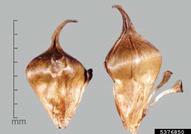| branched burreed | USDA PLANTS Symbol: SPER U.S. Nativity: Exotic Habit: Aquatic Plants Forbs/Herbs |
| Sparganium erectum L. |
Jump to: Resources | Images | Distribution Maps | Sources
|
Taxonomic Rank: Liliopsida: Typhales: Sparganiaceae |
|
| Synonym(s): exotic bur-reed, branched burreed,simple-stem burr-reed, simplestem bur-reed | |
|
|
Identification, Biology, Control and Management Resources
|
| Selected Images from Invasive.org | View All Images at Invasive.org |
 Fruit(s); Fruit. FNW taxon. Julia Scher, USDA APHIS PPQ, Bugwood.org Additional Resolutions & Image Usage |
 Fruit(s); Fruits with spongy layer mostly removed, exposing stony, ridged endocarp. FNW taxon. Julia Scher, USDA APHIS PPQ, Bugwood.org Additional Resolutions & Image Usage |
 Fruit(s); Fruits. FNW taxon. Julia Scher, USDA APHIS PPQ, Bugwood.org Additional Resolutions & Image Usage |
| EDDMapS Distribution: This map is incomplete and is based only on current site and county level reports made by experts and records obtained from USDA Plants Database. For more information, visit www.eddmaps.org |
 State List This map identifies those states that list this species on their invasive species list or law. 
|
| Invasive Listing Sources: |










